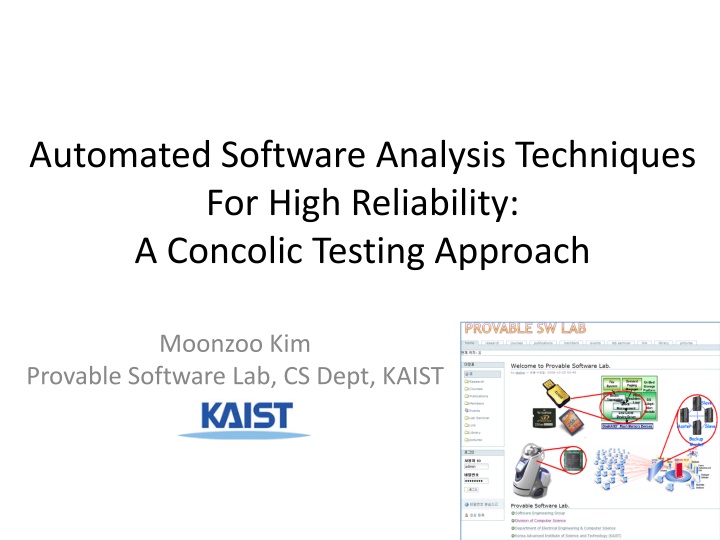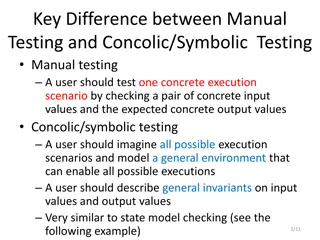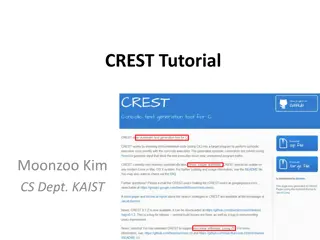
Exploring Automated Software Analysis Techniques
This comprehensive content delves into the field of automated software analysis techniques, focusing on a concolic testing approach for ensuring high reliability in software systems. The text covers background information, the concolic testing process, an example case study, and future directions. It highlights the importance of systematic testing techniques for ensuring software quality and emphasizes the significance of unit testing with automated test case generation. The content also discusses the weaknesses of conventional testing methods and introduces key methods such as symbolic execution, model checking, and concolic testing in software analysis.
Download Presentation

Please find below an Image/Link to download the presentation.
The content on the website is provided AS IS for your information and personal use only. It may not be sold, licensed, or shared on other websites without obtaining consent from the author. If you encounter any issues during the download, it is possible that the publisher has removed the file from their server.
You are allowed to download the files provided on this website for personal or commercial use, subject to the condition that they are used lawfully. All files are the property of their respective owners.
The content on the website is provided AS IS for your information and personal use only. It may not be sold, licensed, or shared on other websites without obtaining consent from the author.
E N D
Presentation Transcript
Automated Software Analysis Techniques For High Reliability: A Concolic Testing Approach Moonzoo Kim Provable Software Lab, CS Dept, KAIST
Contents Automated Software Analysis Techniques Background Concolic testing process Example of concolic testing Case Study: Busybox utility Future Direction and Conclusion Automated Software Analysis Techniques for High Reliability Moonzoo Kim Provable SW Lab 2/42
Main Target of Automated SW Analysis Manual Labor Abstraction Moonzoo Kim Provable SW Lab 3/42
Automated Software Analysis Techniques Aims to explore possible behaviors of target systems in an exhaustive manner Key methods: Represents a target program/or executions as a logical formula Then, analyze the logical formula (a target program) by using logic analysis techniques Symbolic execution (1970) Model checking (1980) SW model checking (2000) Concolic testing (2005 ~) Weakness of conventional testing Moonzoo Kim Provable SW Lab 4/42
Hierarchy of SW Coverages Complete Value Coverage CVC (SW) Model checking Complete Path Coverage CPC Concolic testing Prime Path Coverage PPC All-DU-Paths Coverage ADUP Edge-Pair Coverage EPC All-uses Coverage AUC Complete Round Trip Coverage CRTC Edge Coverage EC All-defs Coverage ADC Simple Round Trip Coverage SRTC Node Coverage NC Moonzoo Kim Provable SW Lab 5/42
Weaknesses of the Branch Coverage /* TC1: x= 1, y= 1; TC2: x=-1, y=-1;*/ void foo(int x, int y) { if ( x > 0) x++; else x--; if(y >0) y++; else y--; assert (x * y >= 0); } yes no x>0 x++ x-- y>0 y++ y-- assert(x*y>=0) Systematic testing techniques are necessary for quality software! -> Integration testing is not enough -> Unit testing with automated test case generation is desirable for both productivity and quality Moonzoo Kim Provable SW Lab 6/53
Dynamic v.s. Static Analysis Dynamic Analysis (i.e., testing) Real result No environmental limitation Binary library is ok Static Analysis (i.e. model checking) Complete analysis result Fully automatic Concrete counter example Pros Cons Incomplete analysis result Test case selection Consumed huge memory space Takes huge time for verification False alarms -> Concolic testing 7/21 7/42
Concolic Approach Combine concrete and symbolic execution Concrete + Symbolic = Concolic In a nutshell, concrete execution over a concrete input guides symbolic execution No false positives Automated testing of real-world C Programs Execute target program on automatically generated test inputs All possible execution paths are to be explored Higher branch coverage than random testing 8 8/42
Overview of Concolic Testing Process 1. 2. Select input variables to be handled symbolically A target C program is statically instrumented with probes, which record symbolic path conditions The instrumented C program is executed with given input values Initial input values are assigned randomly Obtain a symbolic path formula i from a concrete execution over a concrete input One branch condition of iis negated to generate the next symbolic path formula i A constraint solver solves ito get next concrete input values Ex. i: (x < 2) && (x + y >= 2) and i : (x < 2) && (x + y < 2). One solution is x=1 and y=0 Repeat step 3 until all feasible execution paths are explored 3. 4. Itera- tions 5. 6. 7. 9/40
Concolic Testing Example Random testing Probability of reaching Error( ) is extremely low Concolic testing generates the following 4 test cases (0,0,0): initial random input Obtained symbolic path formula (SPF) : a!=1 Next SPF generated from : !(a!=1) (1,0,0): a solution of (i.e. !(a!=1)) SPF : a==1 && b!=2 Next SPF : a==1 && !(b!=2) (1,2,0) SPF : a==1 && (b==2) && (c!=3*a +b) Next SPF : a==1 && (b==2) && !(c!=3*a +b) (1,2,5) Covered all paths and 3*a+b // Test input a, b, c void f(int a, int b, int c) { if (a == 1) { if (b == 2) { if (c == 3*a + b) { Error(); } } } } a!=1 a==1 (0,0,0) b!=2 b==2 Error() reached (1,0,0) c== c!=3*a+b (1,2,0) (1,2,5) 10/42
Example typedef struct cell { int v; struct cell *next; } cell; Random Test Driver: random memory graph reachable from p random value for x int f(int v) { return 2*v + 1; } int testme(cell *p, int x) { if (x > 0) if (p != NULL) if (f(x) == p->v) if (p->next == p) Error(); return 0; } Probability of reaching Error( ) is extremely low Example from the slides CUTE: A Concolic Unit Testing Engine for C by K.Sen 2005 11/42
Concolic Testing Concrete Execution Symbolic Execution typedef struct cell { int v; struct cell *next; } cell; concrete state symbolic state constraints int f(int v) { return 2*v + 1; } p , x=236 p=p0, x=x0 NULL int testme(cell *p, int x) { if (x > 0) if (p != NULL) if (f(x) == p->v) if (p->next == p) Error(); return 0; } 12/42
Concolic Testing Concrete Execution Symbolic Execution typedef struct cell { int v; struct cell *next; } cell; concrete state symbolic state constraints int f(int v) { return 2*v + 1; } p int testme(cell *p, int x) { if (x > 0) if (p != NULL) if (f(x) == p->v) if (p->next == p) Error(); return 0; } , x=236 p=p0, x=x0 NULL 13/42
Concolic Testing Concrete Execution Symbolic Execution typedef struct cell { int v; struct cell *next; } cell; concrete state symbolic state constraints int f(int v) { return 2*v + 1; } int testme(cell *p, int x) { if (x > 0) if (p != NULL) if (f(x) == p->v) if (p->next == p) Error(); return 0; } x0>0 p , x=236 p=p0, x=x0 NULL 14/42
Concolic Testing Concrete Execution Symbolic Execution typedef struct cell { int v; struct cell *next; } cell; concrete state symbolic state constraints int f(int v) { return 2*v + 1; } int testme(cell *p, int x) { if (x > 0) if (p != NULL) if (f(x) == p->v) if (p->next == p) Error(); return 0; } x0>0 !(p0!=NULL) p , x=236 p=p0, x=x0 NULL 15/42
Concolic Testing Concrete Execution Symbolic Execution typedef struct cell { int v; struct cell *next; } cell; concrete state solve: x0>0 and p0 NULL symbolic state constraints int f(int v) { return 2*v + 1; } int testme(cell *p, int x) { if (x > 0) if (p != NULL) if (f(x) == p->v) if (p->next == p) Error(); return 0; } x0>0 p0=NULL p , x=236 p=p0, x=x0 NULL 16/42
Concolic Testing Concrete Execution Symbolic Execution typedef struct cell { int v; struct cell *next; } cell; concrete state solve: x0>0 and p0 NULL symbolic state constraints int f(int v) { return 2*v + 1; } x0=236, p0 NULL 634 int testme(cell *p, int x) { if (x > 0) if (p != NULL) if (f(x) == p->v) if (p->next == p) Error(); return 0; } x0>0 p0=NULL p , x=236 p=p0, x=x0 NULL 17/42
Concolic Testing Concrete Execution Symbolic Execution typedef struct cell { int v; struct cell *next; } cell; concrete state symbolic state constraints int f(int v) { return 2*v + 1; } NULL p p=p0, x=x0, p->v =v0, p->next=n0 , x=236 int testme(cell *p, int x) { if (x > 0) if (p != NULL) if (f(x) == p->v) if (p->next == p) Error(); return 0; } 634 18/42
Concolic Testing Concrete Execution Symbolic Execution typedef struct cell { int v; struct cell *next; } cell; concrete state symbolic state constraints int f(int v) { return 2*v + 1; } p NULL int testme(cell *p, int x) { if (x > 0) if (p != NULL) if (f(x) == p->v) if (p->next == p) Error(); return 0; } p=p0, x=x0, p->v =v0, p->next=n0 x0>0 , x=236 634 19/42
Concolic Testing Concrete Execution Symbolic Execution typedef struct cell { int v; struct cell *next; } cell; concrete state symbolic state constraints int f(int v) { return 2*v + 1; } int testme(cell *p, int x) { if (x > 0) if (p != NULL) if (f(x) == p->v) if (p->next == p) Error(); return 0; } x0>0 p0 NULL NULL p p=p0, x=x0, p->v =v0, p->next=n0 , x=236 634 20/42
Concolic Testing Concrete Execution Symbolic Execution typedef struct cell { int v; struct cell *next; } cell; concrete state symbolic state constraints int f(int v) { return 2*v + 1; } int testme(cell *p, int x) { if (x > 0) if (p != NULL) if (f(x) == p->v) if (p->next == p) Error(); return 0; } x0>0 p0 NULL 2x0+1 v0 p NULL p=p0, x=x0, p->v =v0, p->next=n0 , x=236 634 21/42
Concolic Testing Concrete Execution Symbolic Execution typedef struct cell { int v; struct cell *next; } cell; concrete state symbolic state constraints int f(int v) { return 2*v + 1; } int testme(cell *p, int x) { if (x > 0) if (p != NULL) if (f(x) == p->v) if (p->next == p) Error(); return 0; } x0>0 p0 NULL 2x0+1 v0 p NULL p=p0, x=x0, p->v =v0, p->next=n0 , x=236 634 22/42
Concolic Testing Concrete Execution Symbolic Execution typedef struct cell { int v; struct cell *next; } cell; concrete state solve: x0>0 and p0 NULL and 2x0+1=v0 symbolic state constraints int f(int v) { return 2*v + 1; } int testme(cell *p, int x) { if (x > 0) if (p != NULL) if (f(x) == p->v) if (p->next == p) Error(); return 0; } x0>0 p0 NULL 2x0+1 v0 p NULL p=p0, x=x0, p->v =v0, p->next=n0 , x=236 634 23/42
Concolic Testing Concrete Execution Symbolic Execution typedef struct cell { int v; struct cell *next; } cell; concrete state solve: x0>0 and p0 NULL and 2x0+1=v0 symbolic state constraints int f(int v) { return 2*v + 1; } x0=1, p0 NULL 3 int testme(cell *p, int x) { if (x > 0) if (p != NULL) if (f(x) == p->v) if (p->next == p) Error(); return 0; } x0>0 p0 NULL 2x0+1 v0 p NULL p=p0, x=x0, p->v =v0, p->next=n0 , x=236 634 24/42
Concolic Testing Concrete Execution Symbolic Execution typedef struct cell { int v; struct cell *next; } cell; concrete state symbolic state constraints int f(int v) { return 2*v + 1; } p NULL p=p0, x=x0, p->v =v0, p->next=n0 , x=1 int testme(cell *p, int x) { if (x > 0) if (p != NULL) if (f(x) == p->v) if (p->next == p) Error(); return 0; } 3 25/42
Concolic Testing Concrete Execution Symbolic Execution typedef struct cell { int v; struct cell *next; } cell; concrete state symbolic state constraints int f(int v) { return 2*v + 1; } p NULL int testme(cell *p, int x) { if (x > 0) if (p != NULL) if (f(x) == p->v) if (p->next == p) Error(); return 0; } p=p0, x=x0, p->v =v0, p->next=n0 x0>0 , x=1 3 26/42
Concolic Testing Concrete Execution Symbolic Execution typedef struct cell { int v; struct cell *next; } cell; concrete state symbolic state constraints int f(int v) { return 2*v + 1; } int testme(cell *p, int x) { if (x > 0) if (p != NULL) if (f(x) == p->v) if (p->next == p) Error(); return 0; } x0>0 p0 NULL p NULL p=p0, x=x0, p->v =v0, p->next=n0 , x=1 3 27/42
Concolic Testing Concrete Execution Symbolic Execution typedef struct cell { int v; struct cell *next; } cell; concrete state symbolic state constraints int f(int v) { return 2*v + 1; } int testme(cell *p, int x) { if (x > 0) if (p != NULL) if (f(x) == p->v) if (p->next == p) Error(); return 0; } x0>0 p0 NULL 2x0+1=v0 p NULL p=p0, x=x0, p->v =v0, p->next=n0 , x=1 3 28/42
Concolic Testing Concrete Execution Symbolic Execution typedef struct cell { int v; struct cell *next; } cell; concrete state symbolic state constraints int f(int v) { return 2*v + 1; } int testme(cell *p, int x) { if (x > 0) if (p != NULL) if (f(x) == p->v) if (p->next == p) Error(); return 0; } x0>0 p0 NULL 2x0+1=v0 n0 p0 p NULL p=p0, x=x0, p->v =v0, p->next=n0 , x=1 3 29/42
Concolic Testing Concrete Execution Symbolic Execution typedef struct cell { int v; struct cell *next; } cell; concrete state symbolic state constraints int f(int v) { return 2*v + 1; } int testme(cell *p, int x) { if (x > 0) if (p != NULL) if (f(x) == p->v) if (p->next == p) Error(); return 0; } x0>0 p0 NULL 2x0+1=v0 n0 p0 p NULL p=p0, x=x0, p->v =v0, p->next=n0 , x=1 3 30/42
Concolic Testing Concrete Execution Symbolic Execution typedef struct cell { int v; struct cell *next; } cell; concrete state symbolic state constraints int f(int v) { return 2*v + 1; } solve: x0>0 and p0 NULL and 2x0+1=v0 and n0=p0 int testme(cell *p, int x) { if (x > 0) if (p != NULL) if (f(x) == p->v) if (p->next == p) Error(); return 0; } x0>0 p0 NULL 2x0+1=v0 n0 p0 p NULL p=p0, x=x0, p->v =v0, p->next=n0 , x=1 3 31/42
Concolic Testing Concrete Execution Symbolic Execution typedef struct cell { int v; struct cell *next; } cell; concrete state symbolic state constraints int f(int v) { return 2*v + 1; } solve: x0>0 and p0 NULL and 2x0+1=v0 and n0=p0 x0=1, p0 int testme(cell *p, int x) { if (x > 0) if (p != NULL) if (f(x) == p->v) if (p->next == p) Error(); return 0; } x0>0 p0 NULL 2x0+1=v0 n0 p0 3 p NULL p=p0, x=x0, p->v =v0, p->next=n0 , x=1 3 32/42
Concolic Testing Concrete Execution Symbolic Execution typedef struct cell { int v; struct cell *next; } cell; concrete state symbolic state constraints int f(int v) { return 2*v + 1; } p p=p0, x=x0, p->v =v0, p->next=n0 , x=1 int testme(cell *p, int x) { if (x > 0) if (p != NULL) if (f(x) == p->v) if (p->next == p) Error(); return 0; } 3 33/42
Concolic Testing Concrete Execution Symbolic Execution typedef struct cell { int v; struct cell *next; } cell; concrete state symbolic state constraints int f(int v) { return 2*v + 1; } p int testme(cell *p, int x) { if (x > 0) if (p != NULL) if (f(x) == p->v) if (p->next == p) Error(); return 0; } p=p0, x=x0, p->v =v0, p->next=n0 x0>0 , x=1 3 34/42
Concolic Testing Concrete Execution Symbolic Execution typedef struct cell { int v; struct cell *next; } cell; concrete state symbolic state constraints int f(int v) { return 2*v + 1; } int testme(cell *p, int x) { if (x > 0) if (p != NULL) if (f(x) == p->v) if (p->next == p) Error(); return 0; } x0>0 p0 NULL p p=p0, x=x0, p->v =v0, p->next=n0 , x=1 3 35/42
Concolic Testing Concrete Execution Symbolic Execution typedef struct cell { int v; struct cell *next; } cell; concrete state symbolic state constraints int f(int v) { return 2*v + 1; } int testme(cell *p, int x) { if (x > 0) if (p != NULL) if (f(x) == p->v) if (p->next == p) Error(); return 0; } x0>0 p0 NULL 2x0+1=v0 p p=p0, x=x0, p->v =v0, p->next=n0 , x=1 3 36/42
Concolic Testing Concrete Execution Symbolic Execution typedef struct cell { int v; struct cell *next; } cell; concrete state symbolic state constraints int f(int v) { return 2*v + 1; } Error() reached int testme(cell *p, int x) { if (x > 0) if (p != NULL) if (f(x) == p->v) if (p->next == p) Error(); return 0; } x0>0 p0 NULL 2x0+1=v0 n0=p0 p p=p0, x=x0, p->v =v0, p->next=n0 , x=1 3 37/42
Summary: Concolic Testing Pros Automated test case generation High coverage High applicability (no restriction on target programs) Cons If a target program has external binrary function calls, coverage might not be complete Ex. if( sin(x) + cos(x) == 0.3) { error(); } Current limitation on pointer and array Slow analysis speed due to a large # of TCs Moonzoo Kim Provable SW Lab 39/42
Case Study: Busybox We test a busybox by using CREST. BusyBox is a one-in-all command-line utilities providing a fairly complete programming/debugging environment It combines tiny versions of ~300 UNIX utilities into a sin gle small executable program suite. Among those 300 utilities, we focused to test the followi ng 10 utilities grep, vi, cut, expr, od , printf, tr, cp, ls, mv. We selected these 10 utilities, because their behavior is easy to understand so that it is clear what variables should be declared as symbolic Each utility generated 40,000 test cases for 4 different search strategies 40 3/17/2025 40/42
Busybox Testing Result Utility LOC # of b DFS CFG Random #of covered branch/time Random_input #of covered branch/time Merge of all 4 strategies #of covered branch/time ranch es #of covered branch/t ime #of covered branch/time grep 914 178 105(59.0%)/2785s 85(47.8%)/56s 136(76.4%)/85s 50(28.1%)/45s 136(76.4%) vi 4000 1498 855(57.1%)/1495s 965(64.4%)/1036s 1142(76.2)/723s 1019(68.0%)/463s 1238(82.6%) cut 209 112 67(59.8%)/42s 60(53.6%)/45s 84(75.0%)/53s 48(42.9%)/45s 90(80.4%) expr 501 154 104(67.5%)/58s 101(65.6%)/44s 105(68.1%)/50s 48(31.2%)/31s 108(70.1%) od 222 74 59(79.7%)/35s 72(97.3%)/41s 66(89.2%)/42s 44(59.5%)/30s 72(97.3%) printf 406 144 93(64.6%)/84s 109(75.7%)/41s 102(70.8%)/40s 77(53.5%)/30s 115(79.9%) tr 328 140 67(47.9%)/58s 72(51.4%)/50s 72(51.4%)/50s 63(45%)/42s 73(52.1%) cp 191 32 20(62.5%)/38s 20(62.5%)/38s 20(62.5%)/38s 17(53.1%)/30s 20(62.5%) ls 1123 270 179(71.6%)/87s 162(64.8%)/111s 191(76.4%)/86s 131(52.4%)/105s 191(76.4%) mv 135 56 24(42.9%)/0s 24(42.9%)/0s 24(42.9%)/0s 17(30.3%)/0s 24(47.9%) AVG 803 264 157.3(59.6%)/809s 167(63.3%)/146s 194.2(73.5%)/117s 151.4(57.4%)/83s 206.7(78.4%)/ 1155s 41 3/17/2025 41/42
Result of grep Experiment 1: Iterations: 10, 000 branches in grep.c : 178 Execution Command: run_crest './busybox grep "define" test_grep.dat' 10000 -dfs run_crest './busybox grep "define" test_grep.dat' 10000 -cfg run_crest './busybox grep "define" test_grep.dat' 10000 -random run_crest './busybox grep "define" test_grep.dat' 10000 -random_input Strategy Dfs Cfg Random Pure_random Time cost (s) 2758 56 85 45 42 3/17/2025 42/42
Test Oracles In the busybox testing, we do not use any explicit test oracles Test oracle is an orthogonal issue to test case generation However, still violation of runtime conformance (i.e., no segmentation fault, no divide-by-zero, etc) can be checked Segmentation fault due to integer overflow detected at grep 2.0 This bug was detected by test cases generated using DFS The bug causes segmentation fault when -B 1073741824 (i.e. 2^32/4) PATTERN should match line(s) after the 1stline Text file should contain at least two lines Bug scenario Grep tries to dynamically allocate memory for buffering matched lines (-B option). But due to integer overflow (# of line to buffer * sizeof(pointer)), memory is allocated in much less amount Finally grep finally accesses illegal memory area 43 3/17/2025 43/42
Bug patch was immediately made in 1 day, since this bug is critical one Importance: P5 major major loss of function Busybox 1.18.x will have fix for this bug 44 3/17/2025 44/42
Future Direction Tool support will be strengthened for automated SW analysis Ex. CBMC, BLAST, CREST, KLEE, and Microsoft PEX Automated SW analysis will be performed routinely like GCC Labor-intensive SW analysis => automated SW analysis by few experts Supports for concurrency analysis Deadlock/livelock detection Data-race detection Less user input, more analysis result and less false alarm Fully automatic C++ syntax & type check (1980s) (semi) automatic null-pointer dereference check (2000s) (semi) automatic user-given assertion check (2020s) (semi) automatic debugging (2030s) Automated Software Analysis Techniques for High Reliability Moonzoo Kim Provable SW Lab 45/42
Conclusion: Manual Analysis v.s. Automated Analysis Traditional manual analysis is easy to apply for programs w/ low quality However, automated analysis can achieve high quality cost effectively Automated software analysis techniques are (almost) ready to be applied in industry SW V&V Cost Automated analysis Manual analysis 25% 50% 75% 100% SW Reliability 46/42





